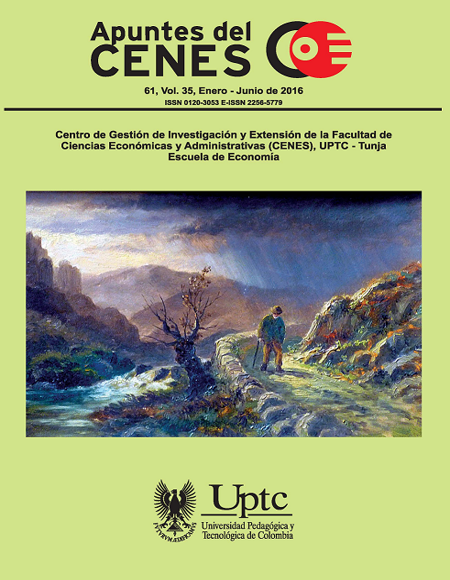The substitution process of heavy fuel oil with natural gas in the industrial sector of Valle del Cauca and Cauca – Colombia 2004-2012

Abstract
The main purpose of this paper is to analyze the substitution process from heavy fuel oil to natural gas by medium-sized and large companies located in Valle del Cauca and the north of Cauca in the period 2004–2012. Likewise, using a random effects Probit model in Panel, the propensity of these industries to substitute highly polluting fuel with natural gas is estimated. The results show that the difference in cost between natural gas and other fuels is a determinant of the probability of replacement. In addition, it is confirmed that the industries with a lower likelihood of carrying out this replacement are those that use coal in their production processes.
Keywords
Alternative energy sources, gasification, panel data model.
References
- Axelsson, E., Harvey, S. & Berntsson, T. (2009). A tool for creating energy market scenarios for evaluation of investments in energy intensive industry.Energy, 34(12),2069-2074. DOI: https://doi.org/10.1016/j.energy.2008.08.017
- Cameron, C. & Trivedi, P. (2010). Microeconometrics using Stata. USA: The Stata Press. Apuntes CENES Volumen 35, Número 61, ISSN 0120-3053enero - junio 2016, Págs. 237-266
- Chalco, V. (2005). Beneficios de la conversión a gas natural en calderas de vapor. Recuperado de http://www.unmsm.edu.pe/cedit/linked/analisis%20de%20cambio%20de%20combustible.pdf
- Dahl, C. A. & Matson, T. K. (1998).Evolution of the US natural gas industry in responseto changes in transaction costs. Land Economics, 390-408. DOI: https://doi.org/10.2307/3147120
- Gases de Occidente S.A. ESP (2013). Extraído de la base de datos de Coordinación grandes consumidores, CD-ROM, Febrero 2013.
- Harris, M. & Rogers, M. (2003). Modelling firm innovations using panel probit estimators. DOI: https://doi.org/10.1080/1350485032000138999
- Melbourne Institute Working Paper, 20(1). DOI: https://doi.org/10.1080/00049999.1959.11509547
- Hsiao, C. (1986). Analysis of panel data. Cambridge: Cambridge University Press.
- IPCC (1996). Revised 1996 IPCC Guidelines for National Greenhouse Gas Inventories:Reference Manual IPCC. U.K.: Bracknell.
- Kozulk, R. (2004). La industria del gas natural en América del Sur: situación y posibilidades de integración de los mercados. Chile: Cepal.
- Lee, W. (2004). US lessons for energy industry restructuring: based on natural gas and California electricity incidences. Energy Policy, 32(2), 237-259. DOI: https://doi.org/10.1016/S0301-4215(02)00287-2
- Longwell, H. J. (2002). The future of the oil and gas industry: past approaches, new challenges. World Energy, 5(3), 100-104.
- Otero, A. (2012). Cali a comienzos del siglo XXI. ¿Crisis o recuperación? Documentos de trabajo sobre economía regional Banco de la Republica, (172). Recuperado de http://mba.americaeconomia.com/sites/mba.americaeconomia.com/files/dtser_ 172.pdf
- Porter, M. (2010). Ventaja competitiva. Creación y sostenibilidad de un rendimiento superior. Madrid: Pirámide.
- Painuly, J. P. & Parikh, J. (1993). Policy analysis of oil substitution by natural gas in India: Transport and industry sectors. Energy policy, 21(1), 43-52. DOI: https://doi.org/10.1016/0301-4215(93)90207-V
- Rodríguez, M. (2006). Estimación de la demanda de combustibles en República Dominicana. Texto 6. República Dominicana: Unidad de Análisis Económico Secretariado Técnico de la Presidencia.
- Wooldridge, J. (2005). Econometric analysis of cross section and panel data. Cambridge, MA: The MIT Press.